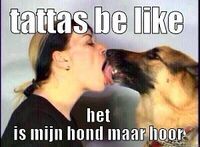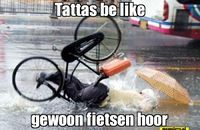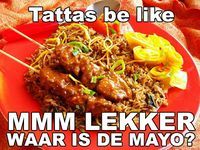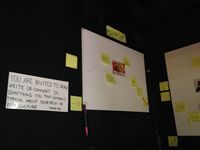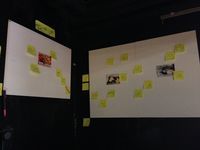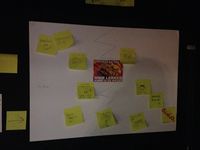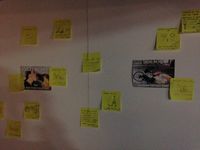Unravel the Code/Unravel the Meme
Project with Eunhyang clair Lee
Team: Meike Brand, Zina Burgers, Nora Mabrouki, Eunhyang clair Lee, Laura Lang, Lisa Vermeer
Theme: Translation (Stereotypes)
TATTAS BE LIKE
Tattas-be-like is a Dutch series of memes, which shows "typical" Dutch stereotypes in a humorous way. The meme shows various clichés, typical behaviour and catchphares associated with caucasian Dutch people.
TATTAS : (urban Dutch slang) originates from the Surinam word "patatas" (potatoes) and is used by Dutch immigrants and non-caucasians to describe caucasian Dutch people.
The Meme originates from a Facebook page, which was launched by Cid (working for Vice) on the 3rd of January 2014. According to Cid, he started the meme after seeing an image of a woman with an aggressive dog with the subscript "Tattas be like.. hij doet niets, aai ‘m maar” (translation: He does nothing, go pet him). He started with making variations of that image showing himself and sharing them on Facebook. At first he postet the images on his own Facebook page. The images started to spread quickly and reached thousands of likes within hours. Therefore he started a Tattas-be-like Facebook page, which got according to him over 100.000 likes within a week. Due to the popularity of the page, a lot of Dutch news outlets and blogs wrote about the page. for example:[ http://www.vice.com/nl/read/de-bedenker-van-tattas-be-like-is-blij-met-de-zelfspot-van-nederland]
Following the popularity of Tattas-be-like a lot of similar pages/memes on different ethical groups and regions emerged. Such as Amsterdammers be like or Rotterdammerts be like.
We could find the original Tattas-be-like page, maybe it got deleted by now. The only Facebook page we found had a lot less likes, than we expected. [ http://www.vice.com/nl/read/de-bedenker-van-tattas-be-like-is-blij-met-de-zelfspot-van-nederland]
Relevanz
To work with the meme Tattas-be-like was in interesting situation/starting point for us, because we are both exchange students and Tattas-be-like is a regional meme therefore we didn't know it before the first class of Digital Crafts. Since all the memes are in Dutch we spend some time with google translate, trying to unterstand the meaning and the jokes. Of course a lot of the humour gets lost in the translation. Still there are some general aspects we found interesting. The meme makes fun of a culture or of specific parts of that culture and at the same time it emerges, is shared and popular within that culture. Futhermore the meme appropriates the word Tattas, which originates from a non-caucasian context and uses it in a new context.
Teamwork, Sources and References
A similar phenomenon from vienna: When you really live in Vienna [1] And from Korea: Today Humor (which is quite difficult to handle if you don't know korean) [2] In the larger group the starting points were the memes Nailed it!, Bad Luck Brain and Tattas be like. We added the song raat Nederlands met me [3] as well as the two reactions to that song. Praat Amsterdams Met Me [4] and Praat Rotterdams Met Me [5] We first came up with the theme Stereotypes, which developed to Translation during the process and discussion.
Within our team three Projects where developed. I was part of Whatever be like and the two others were:
Spoken words Transliteration. Translation. Copy. Paste. Visualisation. Transformation. Wille-Meike Brand, Laura Larissa Lang Spoken words getting transformed by misunderstandings between analogue and digital language, by translation, reproduction and visualisation. The automated process relates to the development of memes and the way they transform within these progressions.
Rotterdamse Vertalert
We made the ‘Rotterdamse Vertalert’. Our main goal is to connect people through complaining in Rotterdam dialect and slang. Because Rotterdam people like to complain, we invite them with the question: ‘What to complain about today?’ If you type a Dutch complaint in our machine, you will get the translation in Rotterdam language.
Rotterdam people also like to share their complaints, so they can spread the word on social media. We invite them by the sentence: ‘Gedeelde leedt is halve leedt, pleurt je vertaalde zin er effies bij dan. Jatochniettan! Just like ‘Tatta’s be like’ this is only understandable for a small subculture. This exclusion makes the connection between the included ones stronger.
So: Effies een potje zeiken in het Rotterdams, dat bekt zo lekker.
Try it! Rotterdamse Vertalert
Whatever be like
„Whatever be like“ deals with our situation of arriving in Rotterdam and getting to know the meme
“Tattas be like” for the first time. Interesting about this meme is, that they are making fun of a
culture and at the same time the phenomenon emerges from within the culture. It's necessary to
know the culture and the language to really understand those memes. Therefore this meme is an
insider joke. We were thinking about the possibility to identify with cultural stereotypes and thought
about stereotypes and typical situations from our own cultures. At the same time the question of
how a meme appears, develops and is translated to different contexts is important. We would like
to create an analog platform for memes and invite the audience to draw, write or leave comments
on sticky notes about something they find stereotypical about themselves, their or another culture.
Within the three days of the exhibition we would to see and show how the drawings and comments develop and if they are influenced by each other. Creating an analog meme.
In terms of translation, we were thinking about the drawings as a form of translation and visulization of stereotypical ideas.
- documentation
